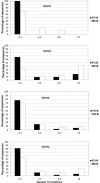The formation of mutated IgM memory B cells in rat splenic marginal zones is an antigen dependent process
- PMID: 31490967
- PMCID: PMC6730915
- DOI: 10.1371/journal.pone.0220933
The formation of mutated IgM memory B cells in rat splenic marginal zones is an antigen dependent process
Abstract
Previous studies in rodents have indicated that only a minor fraction of the immunoglobulin heavy chain variable region (IGHV-Cμ) transcripts carry somatic mutations and are considered memory B cells. This is in marked contrast to humans where nearly all marginal zone B (MZ-B) cells are mutated. Here we show in rats that the proportion of mutated IgM+ MZ-B cells varies significantly between the various IGHV genes analyzed, ranging from 27% mutated IGHV5 transcripts to 65% mutated IGHV4 transcripts. The observed data on mutated sequences in clonally-related B cells with a MZ-B cell or follicular B (FO-B) cell phenotype indicates that mutated IgM+ MZ-B and FO-B cells have a common origin. To further investigate the origin of mutated IgM+ MZ-B cells we determined whether mutations occurred in rearranged IGHV-Cμ transcripts using IGHV4 and IGHV5 genes from neonatal rat MZ-B cells and FO-B cells. We were not able to detect mutations in any of the IGHV4 and IGHV5 genes expressed by MZ-B cells or FO-B cells obtained from neonatal rat spleens. Germinal centres (GCs) are absent from neonatal rat spleen in the first few weeks of their life, and no mutations were found in any of the neonatal sequences, not even in the IGHV4 gene family which accumulates the highest number of mutated sequences (66%) in the adult rat. Therefore, these data do not support the notion that MZ-B cells in rats mutate their IGHV genes as part of their developmental program, but are consistent with the notion that mutated rat MZ-B cells require GCs for their generation. Our findings support that the splenic MZ of rats harbors a significant number of memory type IgM+ MZ-B cells with mutated IGHV genes and propose that these memory MZ-B cells are probably generated as a result of an antigen driven immune response in GCs, which still remains to be proven.
Conflict of interest statement
The authors have declared that no competing interests exist.
Figures




Similar articles
-
Class-switched marginal zone B cells in spleen have relatively low numbers of somatic mutations.Mol Immunol. 2011 Mar;48(6-7):874-82. doi: 10.1016/j.molimm.2010.12.020. Epub 2011 Jan 22. Mol Immunol. 2011. PMID: 21256598
-
Heterogeneity of Memory Marginal Zone B Cells.Crit Rev Immunol. 2018;38(2):145-158. doi: 10.1615/CritRevImmunol.2018024985. Crit Rev Immunol. 2018. PMID: 29887727 Free PMC article. Review.
-
Functional heterogeneity of marginal zone B cells revealed by their ability to generate both early antibody-forming cells and germinal centers with hypermutation and memory in response to a T-dependent antigen.J Exp Med. 2003 Dec 15;198(12):1923-35. doi: 10.1084/jem.20031498. Epub 2003 Dec 8. J Exp Med. 2003. PMID: 14662910 Free PMC article.
-
Most marginal zone B cells in rat express germline encoded Ig VH genes and are ligand selected.J Immunol. 2000 Dec 1;165(11):6156-69. doi: 10.4049/jimmunol.165.11.6156. J Immunol. 2000. PMID: 11086049
-
Human IgM-expressing memory B cells.Front Immunol. 2023 Dec 8;14:1308378. doi: 10.3389/fimmu.2023.1308378. eCollection 2023. Front Immunol. 2023. PMID: 38143767 Free PMC article. Review.
Cited by
-
Immunomolecular and reactivity landscapes of gut IgA subclasses in homeostasis and inflammatory bowel disease.J Exp Med. 2024 Dec 2;221(12):e20230079. doi: 10.1084/jem.20230079. Epub 2024 Nov 19. J Exp Med. 2024. PMID: 39560666 Free PMC article.
-
Human IgMhiCD300a+ B Cells Are Circulating Marginal Zone Memory B Cells That Respond to Pneumococcal Polysaccharides and Their Frequency Is Decreased in People Living with HIV.Int J Mol Sci. 2023 Sep 6;24(18):13754. doi: 10.3390/ijms241813754. Int J Mol Sci. 2023. PMID: 37762055 Free PMC article.
-
Notch2 controls developmental fate choices between germinal center and marginal zone B cells upon immunization.Nat Commun. 2024 Mar 4;15(1):1960. doi: 10.1038/s41467-024-46024-1. Nat Commun. 2024. PMID: 38438375 Free PMC article.
References
-
- Oliver AM, Martin F, Kearney JF. IgMhighCD21high lymphocytes enriched in the splenic marginal zone generate effector cells more rapidly than the bulk of follicular B cells. Journal of immunology. 1999;162(12):7198–207. . - PubMed
Publication types
MeSH terms
Substances
LinkOut - more resources
Full Text Sources

